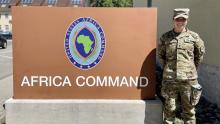Paper: CTCs Must Adapt to ‘Realities of Modern Warfare’

As the Army’s premier training venues for maneuver formations, combat training centers must evolve to match the realities of modern warfare, according to the author of a new paper published by the Association of the U.S. Army.
This includes wargaming pre-deployment activities with an emphasis on critical infrastructure, writes Capt. Daniel Eerhart, a psychological operations officer serving as a cyber policy, law and strategy research scientist at the Army Cyber Institute, in “Training Outside ‘The Box.’ ”









